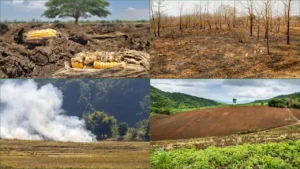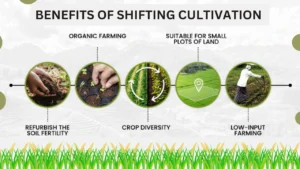Shifting cultivation, also known as slash and burn agriculture, is an ancient agricultural practice used by humankind. It’s a globally used and dynamic method with roots in traditional farming. Shifting cultivation in India holds significant cultural and ecological importance, especially among tribal communities. It’s been more than just agriculture; it represents a way of life for many tribal and international communities as well.
A deep understanding of nature and its cycles, along with harmony between human survival and the environment, are at the centre of this farming approach. As we explore these farming methods, we will learn about their origin, procedures, benefits, and the challenges they face. Also, at the end of the article, we will discover the emerging role of shifting cultivation in this fast-paced, urbanizing era.
Understanding Shifting Cultivation in India

Shifting cultivation is a traditional method of farming that is mainly used in the tropical forest areas. As the name suggests, farmers shift for farming from one land to another. In shifting cultivation, farmers clear the land by burning the plants to generate ashes and use the area of land for farming until that land loses its fertility.
Then, the land is abandoned, and a new piece of land is cleared in the same way for farming. The degraded land becomes fertile again slowly when left for years without farming. In India, it’s a traditional technique, and this type of farming is practiced in many regions, including the Western Ghats, the Eastern Himalayas, some northeastern states, central India, the Andaman and Nicobar Islands, and parts of Jammu and Kashmir.
This shifting farming process is mainly popular in areas with high rainfall and dense forests, such as:
- Southeast Asia (India, Indonesia, Philippines)
- Africa (Congo Basin, West Africa)
- South America (Amazon Basin)
It is a traditional technique in India, and in different places, it is known by many other names, like ladang in Indonesia, jhum in Northeast India, and milpa in Central America.
The Process of Shifting Cultivation
Traditional groups have developed a set of well-designed processes for shifting agriculture over many decades. Every step shows a thorough understanding of the regional environment and customs. Here is a breakdown of the procedure for a complete understanding:
Selecting the Plot
The first step in the procedure is choosing a good piece of land or forest property. Community customs guides in choosing this and also guides in different steps, which include testing the fertility of the soil, about the access of local resources, and the population nearby the land. Here, producers rely heavily on traditional knowledge to select plots that will produce the best results without harming the environment. They often select the land that is abandoned for regrowing and is prepared for farming again.
Clearing the Vegetation
After the site selection, the next step is removing the vegetation. The trees, shrubs, and other plants are cut down manually using simple equipment like axes and machetes.
After that, the chopped vegetation is allowed to dry in the sun. Preparing the land for cultivation by this technique not only makes the land farming ready but also adds organic matter to the soil that eventually helps to improve the soil fertility. Larger trees and sacred flora are prevented from being cut down in this process due to the forest’s spiritual and cultural beliefs.
Burning
After the vegetation gets sun-dried, it is burned in a controlled burning environment. This crucial phase is conducted to achieve these few goals:
It makes it easier to plant crops by clearing the land of waste.
The resulting ash acts as a natural fertilizer by enriching the soil with nutrients like phosphate and potassium.
Burning is carefully controlled to ensure that only the needed plot is removed and to stop the fire from spreading to nearby places.
Sowing and Cultivation
After preparing the land area this way, the farmer starts cultivation of crops in that area. In shifting cultivation, farmers usually grow different crops on the same piece of land, which is called the intercropping method. Farmers in India use this method because, firstly, it eliminates the chance of complete crop failure so that if one crop fails to obtain profit, other crops can remain on the safe side for the farmer’s income.
Secondly, the intercropping method is used to utilize complete fertility and every type of nutrient in the soil. Crops like maize, millet, and rice, and tubers like yams and cassavas are selected by the farmer for cultivation. These crops are selected on the basis of soil structure, nutritional needs of the local population, and other climatic conditions of that area. During planting seeds, farmers use little to no tillage method in order to not disturb the soil structure.
Harvesting
Then the crops are harvested after they reach maturity, mostly after two or three years that totally depend upon the land fertility. In this time period, the plot fulfills the needs of food and economic resources for the community.
Alongside, farmers keep noticing the land and soil behaviours and plans for shifting to a new plot for farming when the current land becomes infertile. This monitoring ensures that the land will not lose its complete nutrients and will not be overused, as complete infertility can lead to long-term harm to the ecology.
Abandonment and Fallow Period
As the land starts losing its fertility soon, it is left fallow to process its natural regaining of nutrients and fertility. At this abandoned time, the forest takes the land under their supervision, and the natural composting of trees and organic matter helps the soil to regain its fertility. This duration of leaving the land fallow can generally be from five to twenty years, or it also depends on the availability of another land area.
Communities also allow the land to rest during this period by preventing any human activity from interfering with it.
The Importance of Shifting Cultivation for the Traditional Societies
Shifting cultivation practices have been the backbone of traditional farming cultures, maintaining a healthy interaction with the earth over the years. This practice is embedded deep in the culture and spirituality of the first inhabitants and serves as a permanence. This practice of cultivation is also useful in regions with low agricultural potential.
It is possible to secure food using various methods. In addition, shifting cultivation aids in fostering social relations beyond the agricultural sphere as it is a communal activity where people come together to organize the work, finances, and skills. The activities and ceremonies related to this way of life serve to strengthen their identity and transform it from a mere agricultural technique to a culture of life rooted in the ideals of the locality.
Also, Read: Subsistence Farming: Sustaining Livelihoods and Nurturing Communities
Benefits of Shifting Cultivation in India

Economically Friendly
Since shifting cultivators do not need expensive equipment, high-priced chemical fertilizers, or pesticides, it is one of the cheapest methods of farming. For this type of farming, inexpensive physical labor and resources available in the vicinity are utilized. Hence, it’s an affordable farming method that stimulates economic activity in these undeveloped regions and boosts employment through the use of local traditional tools and finances.
Sustainable
Finally, one of the best advantages of shifting cultivation is that its sustainability-focused. Giving time in between the cultivation of different crops allows the particular soil to naturally recover and aids environmental equilibrium. It enhances biodiversity, safeguards the land from overexploitation, and aids in the development of habitats for animals. Shifting cultivation complements the ecosystem processes and are beneficial in forest restoration and management.
Shifting cultivation is not merely a farming technique as some people may perceive. A way of life among many of our farmers because it incorporates a lot of religion and custom. As a method of maintaining farming, the ecosystem, intergenerational knowledge transfer exercises, group activities, and rituals strengthen cultural identity and allow the farmers to bond with the land.
Shifting cultivation is so versatile that it can endure even the most unforgiving terrains such as hills or dense forests where modern farming techniques have failed. It improves food security through crop diversification while enabling effective self-sustained farming in poor soil conditions. It is a great technique for lowly populated and underdeveloped areas because little infrastructure is required, and resources are scarce. Because of the lack of accessible resources, shifting cultivation proves to be useful for those remote regions.
Challenges Facing Shifting Cultivation
While shifting agriculture has many benefits, it also has some limitations in our modern world, much like everything else.
Environmental Issues and Deforestation
Poor management of forest clearings will contribute to habitat and biodiversity loss plus greater greenhouse gases emissions.
Population Pressure
Population growth has increased the demand for land which decreases the fallow period and inhibits soil recovery.
Land Rights and Government Policies
In many countries, it is considered damaging and primitive. Governments often restrict it, leading to conflicts with native people.
Economic Pressures
Traditional farmers are now being forced into cash crops and commercial farming, which threatens the very existence of this age old practice.
Climate Change
Greater variance in weather and reduced precipitation makes shifting farming more difficult in certain regions.
Shifting Cultivation in Modern Times
With the advancement of technology and the world becoming more urbanized, shifting cultivation is indeed being reevaluated. Its potential as a sustainable practice should not be ignored, despite its environmental impacts being worrying. There are attempts to merge modern agricultural practices with traditional wisdom.
Agroforestry allows for tree planting alongside shifting cropping in order to ensure production and biodiversity conservation. With regards to Policy Interventions, governments should promote policies that assist semi-nomadic shifting cultivators in their efforts to practice sustainable farming.
This encourages a balance between development and conservation. Programs should be developed by governments and NGOs in a way that allows these cultures to merge with sustainable alternatives. Policies should allow the Mayan populations to freely utilize their resources within agronomic zones to practice shifting cultivation and preserve resource areas.
The combination of innovation and balancing shifting cultivation with traditional approaches needs broadening and is critical for the future of this practice. This includes having policies that allow for respecting indigenous skills as well as acknowledging their practical inherited skills that are passed down from ancient times.
Global Collaboration: Governments, NGOs, and environmental bodies must work together to transform shifting cultivation in India to a more sustainable farming technique worldwide.
Educational Campaign: There is a serious need to demystify shifting cultivation. The best way to do so is to teach the public about its ecological benefits and relevance to culture.
In Closing
Shifting cultivation is a perfect example for how people and nature can coexist. It is far more than a farming practice, shifting cultivation in India explains just how much people are able to cohabit with nature. This is true, but with urbanization and modernization, there is a lot of cap for turning this type of farming into a sustainable one. After all, shifting agriculture is able to shift us into the future for generations without losing tradition. There’s no doubt that we are able to transform kinesthetic models of innovation and sustainable ‘shifting’ behavior. We shift the bond with nature while shifting the spirits of innovation.
Also, Read: Subsistence farming- Definition, Characteristics & Types

